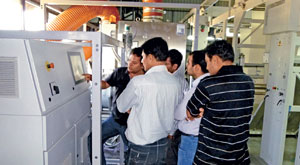
Brückners climate-friendly technologies for India
Subsidised by the German Ministry for the Environment and Nature Protection as well as the German Investment and Development Company, the newly-adopted development project in India by Brückner will sensitise the decision-makers in producing companies and train the qualified personnel.
Subsidised by the German Ministry for the Environment and Nature Protection as well as the German Investment and Development Company, the newly-adopted development project in India by Brückner will sensitise the decision-makers in producing companies and train the qualified personnel.
The Brückner group of companies is since 65 years worldwide. Innovation, sustainability and the highest quality and reliability "made in Germany" are the most important factors of our success. In Europe, drying lines are almost exclusively operated with heat-recovery units. In some countries this is even prescribed by the law. In other countries such as in the big textile-focused India the costs for energy are partially subsidised. This increases the pay-off time of energy saving systems considerably. In addition, the investment budgets are often very low and leave no room for such systems because the big trade chains from Europe and the US are very price-driven in their purchase of clothing and home textiles. But the public questions more and more the production conditions and the compliance with ecological standards.
As per todays estimates, India will be already in 2025 the most populous country in the world with 1.5 billion people. As emerging market it will undergo a similar development as China and the energy demand will probably increase disproportionately. On a global scale, the Indian textile sector plays an important part. About 66 billion kWh thermal energy are required for this quantity, which corresponds to a consumption of approx. Approximately 1.1 mt of coal when this fuel is used. Given a simultaneous energy saving of about 10 per cent by heat-recovery systems would allow the saving of yearly 230 tonnes of CO2 in the Indian textile industry alone. The prerequisite for this would be that all lines are provided with a heat-recovery system.
The production and use of process energy in the Indian textile industry takes place often with old concepts and systems and leads therefore to considerably negative consequences for the environment. It is our responsibility to inform our customers also in India about the possibilities to save energy and to show them ways for a better protection of our environment.
Particularly in case of energy-intensive processes such as the drying or heat-setting of textiles and other materials present an enormous energy saving potential. Some years ago, we began with a development project to show these potentials, the central point of which was to use a mobile heat-recovery unit in several Indian textile companies. The German Ministry for the Environment and Nature Protection (BMU) as well as the German Investment and Development Company (DEG) accompanied and subsidised this project. The ministry supports projects which serve to spread climate-friendly technologies in developing countries and emerging markets.
This project is intended to sensitise the decision-makers in producing companies and to train the qualified personnel. In the framework of this project, we planned and built a mobile heat-recovery unit. This mobile heat-recovery unit has been installed for the first time at our customer Arvind in Ahmedabad, India. The unit was several weeks in operation, the energy savings have been recorded and documented. At the same time, we used the opportunity to train the operators regarding the optimum production sequence and possible optimisation potentials. As support for this first test phase, we made a symposium in Ahmedabad for other interested companies. By and by we installed the mobile unit at a total of nine Indian companies to convince them of possible energy savings but also of the CO2 reduction in the production. At five symposiums in different Indian sites we reported about the project and about the successes achieved up to that moment. It is a great joy for us that Arvind decided in the meantime to buy a new Brückner machine due to the successful realisat



